| [Index] |
| John Vaughan THOMPSON (1779 - 1847) |
| FLS, military surgeon, marine biologist, Zoolgist, botanist, naturalist |
| Children | Self + Spouses | Parents | Grandparents | Greatgrandparents |
|
Ellen Vaughan THOMPSON (1821 - 1887) |
John Vaughan THOMPSON (1779 - 1847) + Martha SOLOMON (1800 - 1832) Deborah (THOMPSON) |
John THOMPSON | ||
| Jane HALL | ||||

|

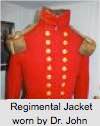
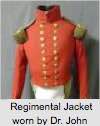
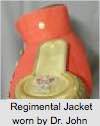
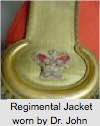
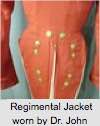
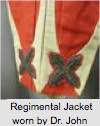
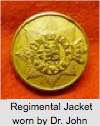
|
|
Pic P1. Doctor John Vaughan Thompson wearing the uniform of an officer in the Royal Army Medical Corps. Painting by D. Roux, London, circa August 1835. Pic 1. Doctor John Vaughan Thompson wearing the uniform of an officer in the Royal Army Medical Corps. Painting by D. Roux, London, circa August 1835. Pic 2. http://www.australiandressregister.org/garment/386/ Pic 3. http://www.australiandressregister.org/garment/386/ Pic 4. http://www.australiandressregister.org/garment/386/ Pic 5. http://www.australiandressregister.org/garment/386/ Pic 6. http://www.australiandressregister.org/garment/386/ Pic 7. http://www.australiandressregister.org/garment/386/ Pic 8. http://www.australiandressregister.org/garment/386/ |
| b. 19 Nov 1779 at Brooklyn, New York, USA |
| m. (1) 02 May 1817 Martha SOLOMON (1800 - 1832) at Cork, Ireland |
| m. (2) 1832 Deborah (THOMPSON) |
| d. 21 Jan 1847 at Sydney, New South Wales, Australia aged 67 |
| Parents: |
| John THOMPSON |
| Jane HALL |
| Children (1): |
| Ellen Vaughan THOMPSON (1821 - 1887) |
| Events in John Vaughan THOMPSON (1779 - 1847)'s life | |||||
| Date | Age | Event | Place | Notes | Src |
| 19 Nov 1779 | John Vaughan THOMPSON was born | Brooklyn, New York, USA | |||
| 02 May 1817 | 37 | Married Martha SOLOMON (aged 17) | Cork, Ireland | ||
| 1821 | 42 | Birth of daughter Ellen Vaughan THOMPSON | Cork, Ireland | ||
| 1832 | 53 | Married Deborah (THOMPSON) | |||
| 1832 | 53 | Death of wife Martha SOLOMON (aged 32) | Cork, Ireland | ||
| 21 Jan 1847 | 67 | John Vaughan THOMPSON died | Sydney, New South Wales, Australia | V1847286 32B/1847 | |
| Personal Notes: |
|
Oxford Dictionary of Biography
http://www.oxforddnb.com/view/printable/27273 Thompson, John Vaughan (1779–1847), surgeon and naturalist, was born on 19 November 1779, in Berwick, the son of John Thompson and his wife, Jane Hall, both of Berwick. That he had an early interest in the natural history of the area is demonstrated by the preparation, before he left Berwick and England, of his Catalogue of Plants Growing in the Vicinity of Berwick upon Tweed (1807). His skill as a botanist is revealed in this work, which, according to Britten (1912), exhibited ‘a very complete knowledge of the plants of that region and of the literature of the period’ and the talent of ‘a capable artist’. The Catalogue also refers to the botanical guidance given to Thompson by William Percival Pickford of Edinburgh, presumably when he was a medical student in that city in 1797 and 1798. In addition to botany Thompson studied chemistry, anatomy, midwifery, and surgery, presumably with some distinction, as at the age of twenty he was appointed as assistant surgeon to the Prince of Wales's fencibles. In December 1799 Thompson sailed with the 37th regiment for Gibraltar, and three months later accompanied it to the West Indies and Guiana where British troops were engaged in fierce fighting against the Dutch. Thompson was in the Caribbean for nine years, rising in rank to full surgeon in 1803. While there he continued his interests in natural history, describing a new species of pouched rat from Jamaica, and observing the spawning behaviour of land crabs. Towards the end of 1809 Thompson returned to England and was elected a fellow of the Linnean Society on 6 February 1810. In 1812 he sailed for the Indian Ocean, where he spent four years attached to the garrisons of Madagascar and Mauritius. Given the title of government agent for Madagascar, he undertook important political duties in addition to his medical practice. He also spent considerable time exploring the natural history of the two islands. He discovered in Madagascar a plant for which Robert Brown erected the genus Thompsonia (now Deidamia) and researched the island's extinct birds, eventually writing an article on the dodo for the Magazine of Natural History (1829). Thompson also produced A Catalogue of the Exotic Plants Cultivated in the Mauritius (1816), the first list of the island's plants. Thompson returned to Britain in 1816 and was posted to Cork in southern Ireland as surgeon to the forces. By 1830 he had attained the senior rank of deputy inspector-general of hospitals, an appointment he held at Cork until 1835. In that year he was posted as medical officer in charge of the convict settlements of New South Wales, and never returned to Europe. Although his publications reveal an early interest in marine bioluminescence (he later wrote vividly about the phenomenon he witnessed first off Gibraltar about 1810) it was on the voyage home from the Mascarene Islands in 1816 that Thompson first used a fine-meshed net to try and capture the organisms that caused it. Writing about the experience he stated Individually I feel under great obligations to this beautiful little animal, which by its splendid appearance in the water induced me to commence the use of a muslin hoop-net, which when it failed to procure me a specimen, brought up such a profusion of other marine animals altogether invisible while in the sea, as to induce a continued use of it on every favourable opportunity. The ‘beautiful animal’ (J. V. Thompson, Zoological Researches and Illustrations, 1828–1834, 1968, 47) was a copepod (Crustacea) that he later named Sapphirina indicator. Thompson not only mastered the use of a fine-meshed net from a moving vessel, but also developed the ingenious method of fastening the net over the spout of the ship's sea water pumps—arguably the first use of a continuous plankton sampler. In terms of his scientific work, Thompson's years at Cork were those of his most productive research, through which he: secured a permanent place in zoological literature through his discoveries of the nature and life histories of the feather star …, the polyzoa, the cirripedes (or barnacles) and several divisions of the crustacea. Our present conceptions of the structure of these forms, of their zoological position, and of the metamorphoses which they undergo, date from Thompson's papers. (DNB) Thompson's privately printed series of memoirs on marine biology, his Zoological researches and illustrations, or, Natural history of nondescript or imperfectly known animals was conceived either in 1826 or early in 1827. This series of six memoirs (in five numbers) appeared between 1828 and 1834. Thompson published his Memoir on the Pentacrinus europeaus in 1827 and an erratum slip for this paper issued in May 1827 announced his intention to publish Zoological Researches. This paper was more fully developed in the Edinburgh New Philosophical Transactions in 1836, and its startling conclusions—that crinoids were echinoderms and that the Pentacrinus was a young stage of the feather star Antedon—attracted the notice of zoologists throughout Europe. However, the Zoological Researches became the principal vehicle for Thompson's discoveries. His skill with the plankton net—developed on the voyage from Mauritius—was used to good effect in the waters off Cork, and the majority of the papers published in the Researches relate to the metamorphosis of marine animals (mainly Crustacea) that he found in the plankton. These were remarkable and original discoveries. Thompson's observation of the metamorphosis of the Zoea larva of the edible crab (then regarded as a species in its own right) into an adult led to his suggestion that larval stages and metamorphosis were universal in decapod Crustacea. This view was criticized by N. A. Vigors, editor of the Zoological Journal, who felt that this was a sweeping conclusion, and Thompson's opinions remained controversial. Thompson's discoveries of metamorphosis in barnacles enabled him to place the cirripedes within the Crustacea, rather than one of the classes of Mollusca, a major zoological achievement. It was in light of Thompson's major re-evaluation of barnacles as Crustacea—not molluscs as had previously been thought—that Darwin was able definitively to monograph the group in the early 1850s. More controversially, Thompson erected the name Polyzoa at the same time as Ehrenberg proposed the name Bryozoa for the same group of small colonial invertebrates. This caused confusion and controversy for many years, resolved only as late as 1947. However, Thompson's work on this group of animals was as meticulous as all his previous research, and his dissections and figures of them were a major contribution to understanding their structure, classification, and relationships. Thompson died in Sydney on 21 January 1847. Thompson's studies in marine biology, published in a relatively short period between 1823 and 1836, revolutionized some aspects of zoological thought. His name is unfamiliar however, even to marine zoologists, partly because of the general absorption of his discoveries and the waning of the controversies his research caused. He has not escaped recognition entirely, however, with distinguished naturalists including Charles Darwin, E. R. Lankester, T. R. R. Stebbing, C. M. Yonge, and Sir Sidney Harmer recognizing and paying tribute to his genius. The reproduction of a facsimile of the Zoological Researches in 1968 has also enabled his contribution to science to be better appreciated. PETER DAVIS Sources A. C. Wheeler, ‘An introduction to the Zoological Researches of John Vaughan Thompson’, in J. V. Thompson, Zoological researches and illustrations, 1828–1834 (1968), i–vi · DNB · J. Britten, ‘John Vaughan Thompson (1779–1847)’, Journal of Botany, British and Foreign, 50 (1912), 169–71 · R. E. Vaughan, ‘A forgotten work by John Vaughan Thompson’, Proceedings of the Royal Society of Arts and Science of Mauritius, vol. 1/pt 3 (1953), 241–8 Archives Linn. Soc., corresp. and papers Wikipedia entry http://en.wikipedia.org/wiki/John_Vaughan_Thompson John Vaughan Thompson FLS (November 19, 1779 – January 21, 1847) was a British military surgeon, marine biologist, zoologist, botanist, and published naturalist. Early years John Vaughan Thompson was born in British controlled Brooklyn on Long-Island in the Province of New York, North America on the 19 November 1779. The family returned to England sometime after the American victory in the American War of Independence. He studied medicine at the University of Edinburgh (1797–1798), reading anatomy, surgery, midwifery and botany before joining the Army in 1799. Work He grew up around Berwick-upon-Tweed where he wrote his first book A Catalogue of Plants Growing in the Vicinity of Berwick Upon Tweed which was published in 1807. In each of his military postings such as the West Indies and Guiana (1800–1809), Mauritius and Madagascar (1812–1816), he continued his natural history studies with two of his papers being read before the Linnean Society on London in 1807, the first On the genus Kaempferia in April 1807 and the second An Account of Some New Species of Piper in June, both of these were submitted on his behalf by Francis Mackenzie, 1st Baron Seaforth F.R.S and L.S. In 1816, he was posted to Cork in Ireland as Surgeon to the forces and later as Deputy Inspector General of Hospitals. While in Cork he published several works including "Zoological researches and illustrations" (1828) which is listed as having been taken by Charles Darwin on his famous Second voyage of HMS Beagle. Death In 1835, he was transferred to Sydney, Australia as Deputy Inspector General of Hospitals in New South Wales, a position he held till he retired in 1844. He Died at his home in Sydney, New South Wales on 21 January 1847. Born November 19, 1779 Brooklyn, New York, USA Died January 21, 1847 (aged 67) Sydney, Australia Resting place Headstone was at Glouster St., Cemetery NO. 451 later removed to La Perouse, Sydney. Residence 136 Liverpool Street, Sydney Nationality British Alma mater University of Edinburgh (1797–1798) Known for Pentacrinus Europæus, Crab metamorphosis, Barnacles, Polyzoa Spouse Martha Solomon (married 1817–1832) Deborah (married 1832) Children 8 children From wikisource http://en.wikisource.org/wiki/Thompson,_John_Vaughan_%28DNB00%29 THOMPSON, JOHN VAUGHAN (1779–1847), zoologist, was born on 19 Nov. 1779, and when a youth lived at Berwick-on-Tweed, where he learnt medicine and surgery. At the age of twenty Thompson joined the Prince of Wales's fencibles as assistant surgeon, and on 15 Dec. 1799 was ordered to sail with the 37th foot for Gibraltar. Three months later his regiment embarked for the West Indies and Guiana, to take part in the war against the Dutch, and in the engagements that followed Thompson was present (as staff-surgeon) at the taking of Demerara and Berbice, and was made full surgeon in 1803. In 1807 he published a ‘Catalogue of Plants growing in the vicinity of Berwick-on-Tweed.’ While in the military service he interested himself in zoological work. During his nine years' service in the West Indies he described in 1809 a new pouched-rat from Jamaica, Mus anomalus (Trans. Linn. Soc. vol. ii. 1815), while he observed and was the first to explain the habit of land-crabs in going down to the sea to spawn, and the changes of form which the young crab undergoes during development. At the close of 1809 Thompson returned to England, and on 6 Feb. 1810 was elected to the fellowship of the Linnean Society, in whose ‘Transactions’ (1808, vol. ix.) his observations on certain British birds had already been published. In 1812 Thompson sailed for Madagascar and the Mauritius, where he spent four years. He was deputed to introduce vaccine into Madagascar for two successive years, and devoted a considerable part of the remainder of the time to an examination of the famous extinct Mascarene birds. His observations on the dodo appeared in the ‘Magazine of Natural History’ for 1829. After his return in 1816 Thompson settled at Cork as district medical inspector, and completed those wonderful discoveries of the life-histories of the marine invertebrata of the Cove of Cork, which made his name famous. In 1830 he was appointed deputy inspector-general, and in 1835 he went to Sydney in charge of the convict medical department and as acting officer of health. He remained in New South Wales until his death at Sydney on 21 Jan. 1847. Vaughan Thompson has secured a permanent place in zoological literature through his discoveries of the nature and life-histories of the feather-star (Antedon, belonging to the Crinoid echinodermata), the polyzoa, the cirripedes (or barnacles), and several divisions of the crustacea. Our present conceptions of the structure of these forms, of their zoological position, and of the metamorphoses which they undergo, date from Thompson's papers. The first of these, ‘A Memoir on Pentacrinus Europæus, a recent species discovered in the Cove of Cork’ (1 July 1823, Cork, 4to, 2 plates), announced the presence of a stalked crinoid in our seas; the discovery that the crinoidea were truly ‘radiata,’ and that (as was shown more fully by a second paper in the ‘Edinburgh New Philosophical Transactions,’ 1836) this pentacrinus was really the young stage of antedon, the feather-star. These startling conclusions drew the attention of zoologists in France, Germany, and elsewhere to Thompson's work, and many of his succeeding papers were translated or abstracted into scientific journals abroad. In September 1828 there appeared the first number of Thompson's ‘Zoological Researches,’ published at Cork, containing an account of the life-history of the shore-crab. With the exception of Slabber, who published some observations on the subject at Haarlem in 1778, Thompson was the first to point out that, contrary to the received opinion, the crab passes through such a remarkable series of changes of form and structure in attaining the adult condition as to constitute a veritable metamorphosis. The greater part of the remainder of Thompson's work, of which six numbers appeared between 1828 and 1834, consisted in the detection of the metamorphosis in other groups of the crustacea. His third discovery was the nature and life-histories of barnacles (Zool. Researches, No. iii., 1830, and Phil. Trans. 1835). Up to 1830 these animals, chiefly owing to Cuvier's influence, had been classed with the mollusca. Thompson showed that from their structure, and the nature and fate of their larvæ, the cirripedes must be considered to form a division of the crustacea. The last of Thompson's more important discoveries was that of ‘Polyzoa, a new Animal discovered as an Inhabitant of some zoophytes’ (Zool. Researches, No. iv., Memoir v., December 1830). This paper demonstrated ‘another form of animal not hitherto known, and which, while it must be allowed to belong to a new type of mollusca acephala, resembles exteriorly in some measure the hydra.’ ‘This discovery will remove that part of the sertularia not provided with distinct oviferous receptacles to the class mollusca acephala, as well as such other genera as may hereafter be found similarly circumstanced.’ These and other passages clearly show that Thompson used the term ‘polyzoa’ as the name of a colonial animal exhibiting a distinct type of structure and hitherto confounded with hydroid polypes (for the discussion of Thompson's meaning of polyzoa see Hinck's British Marine Polyzoa, i. 131). There is no complete list of Vaughan Thompson's works. Papers contributed by him to learned societies are to be found in the Royal Society's ‘Catalogue’ (v. 958–9). Besides an important paper (Entomol. Mag. 1836) containing a large number of observations on Sacculina, a parasite of crabs, on land crabs, and other crustacea, Thompson evidently wrote, but never published, works on the development of parasitic copepoda, since he announced several discoveries in the covers of his ‘Zoological Researches.’ His last papers dealt with the growing of cotton and sugar-cane (India Agric. Soc. Journal, 1842–5, vols. i–iv.) Vaughan Thompson's work has not been fully appreciated. Probably no naturalist has ever written so little, and that so good. In his lifetime the discoveries Thompson made were combated by men of authority, and since his death they have too often been accepted without due acknowledgment or have been attributed to later observers. |